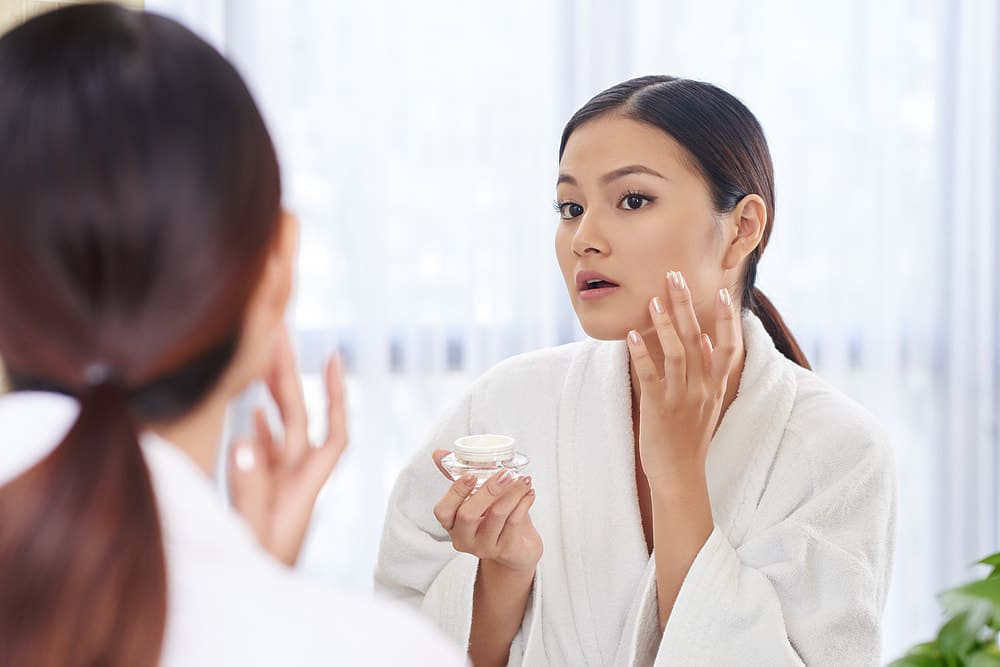
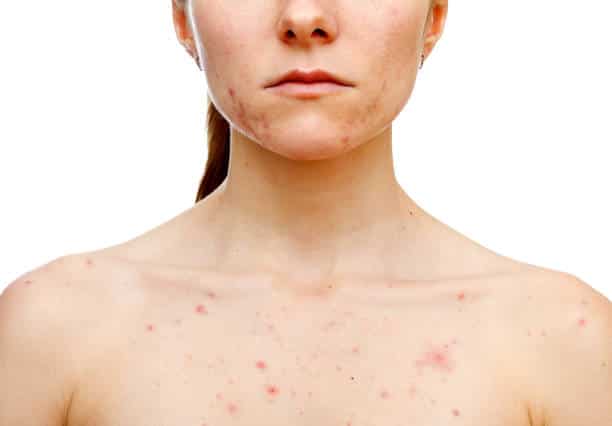

Rosacea is very often mistaken as an acne condition due to the similarities that it can present with. This is compounded by the fact that it is also commonly termed ‘acne rosacea’ in medical websites and online literature when in fact, acne and rosacea are not always mutually inclusive!
The term ‘acne rosacea’ was first coined by an English dermatologist named Robert Willan (1757-1812) who practised at the Carey Street Dispensary in London, among one of the first ever institutions to study specific diseases of the skin. He chose the term because of its similarities to acne vulgaris, and also to highlight the most striking characteristic of this condition – the redness of the sufferer’s skin.
It was not only in England that this thinking was common, as dermatologists in France reported that the cause of rosacea was because of blocked sebaceous glands (oil glands), similar to the pathogenesis of acne vulgaris. This thinking lasted all the way until the early 19th Century. Currently, modern dermatologists understand that rosacea and acne vulgaris are two different conditions although they may have some symptoms that overlap. This article will go through the symptom comparisons between acne and rosacea for a better understanding of these two conditions.
Acne often affects the adolescent population – statistics report about 85% of acne sufferers are in this age range – and rosacea can happen at any age, although patient surveys tend to indicate that it may more commonly be triggered after the age of 30 years old. Acne tends to affect females more than males (the male to female ratio is said to be around 1:1.81!) and likewise, rosacea also tends to be reported more in females. Age and gender aside, the signs and symptoms of rosacea and acne can look very similar but actually differ when we take a deeper look at them individually.
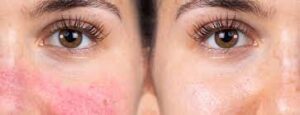
Rosacea – The main causes of rosacea appears to be down to genetics (researchers say that genetics play a role of up to 46% in the development of rosacea) and an autoimmune response of the body. The two genes found to be related to rosacea were also closely related to the immune system, causing a more easily triggered inflammatory response in the skin which results in redness, tenderness, and inflamed lesions. Demodex mites are also hypothesised to be a contributing factor to rosacea. These microscopic mites, which vary in size from 0.1 mm to 0.4 mm long, are commonly found on the face in hair follicles, oil glands, and eyelid glands. It is suspected that Demodex may produce small amounts of bacteria that rosacea sufferers are more sensitive to, resulting in inflammation.
Acne – The major cause of acne is thought to involve increased sebum production, rapid multiplication of keratinocytes (skin cells in the topmost layer), and changes in bacterial colonisation, all of which lead to inflammation in the skin. Although the exact sequence of what comes first is still unclear, the main driving factor seems to be hormonal changes that cause an increase in oil production. This is mainly why 85% of acne sufferers are adolescents, as hormonal changes tend to occur in this stage.
Rosacea – Skin barrier destruction is a side effect of rosacea due to the inflammatory mechanisms that can lead to thinning of the skin layer. Blood capillaries are often obviously seen on the skin. Due to skin barrier dysfunctions, it can lead to reduced hydration levels in the skin and abnormal oil production. Therefore, increased sebum production is a result of rosacea and not the cause of it.
Acne – Contrary to rosacea, the main cause of acne is an increase in sebum production. There is also an increased proliferation of skin cells, causing bacteria and oil to become trapped inside small facial hair follicles which become covered by dead skin cells. The skin barrier is not ‘thinned’ but can form a ‘thicker’ layer more quickly if the dead cells are not shed off.
Rosacea – There tends to be the presence of papules or pustules that come and go, usually without blackheads or whiteheads around those areas. There may also be raised, scaly, red or whitish patches on the skin also known as ‘plaques’ that grow over the affected areas over time which are not seen in acne.
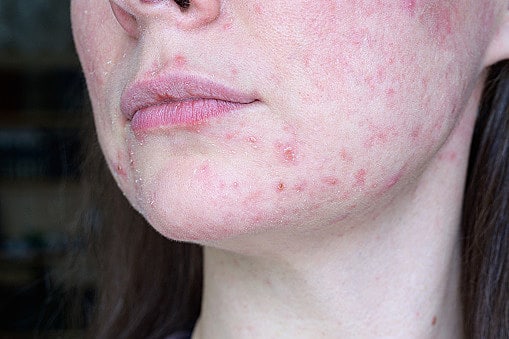
Acne – Those suffering from mild acne will have closed comedones (blackheads or whiteheads), and those with more moderate to severe acne will have more noticeable inflamed pimples called papules (small bumps) or pustules (reddish bumps filled with yellow pus). The greater the frequency of comedones, papules, or pustules, the more severe the acne.
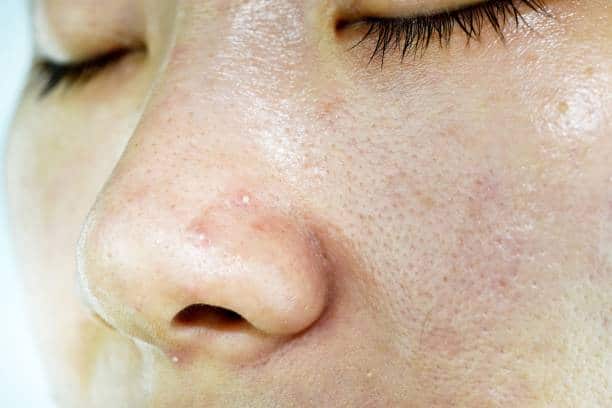
Rosacea – There tends to be constant watering and tearing up during a rosacea flare, and can also cause blocked oil ducts in the eyelids. There may also be dryness, blurry vision, and sensitivity to sunlight, all of which can be misdiagnosed as an eye infection.
Acne – Eye symptoms do not usually occur in true acne conditions.

Acne vulgaris most commonly affects areas of the skin which have a high density of sebaceous glands (oil glands). This means that acne affects the face (99% of cases), the back, and the chest (60% and 15% of cases respectively). Around the face, the areas that will have a higher concentration of whiteheads, blackheads, or pustules are the T-zone (forehead and nose) and jawline.
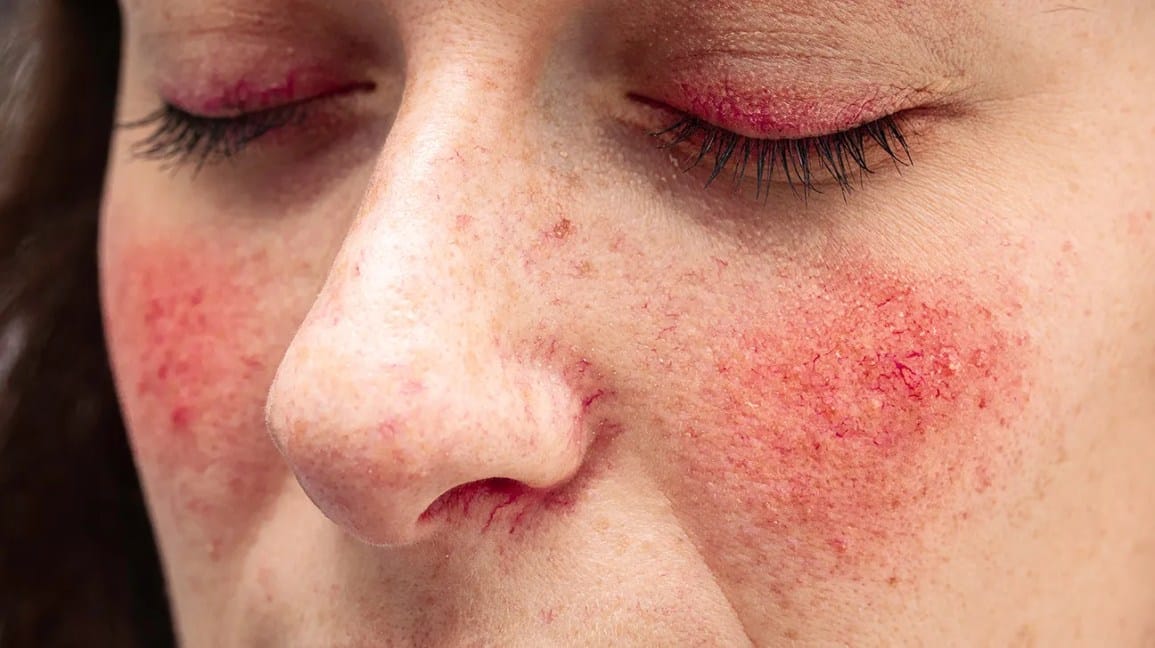
Rosacea predominantly affects the eyelids, cheeks, chin, and nose. There will be more flushing and redness over the nose and cheeks, and dilated or broken blood vessels located near the surface of the skin or around the creases of the nose. Males tend to have more involvement of papules or pustules around the nose, resulting in what people call a ‘strawberry nose’.
Treatments will often involve:
Oral treatments – A course of oral antibiotics may be given for both rosacea or acne conditions if papule/pustule symptoms are severe. For excessive facial flushing in rosacea, beta blockers may be prescribed to reduce blood flow to skin surface tissues.
Topical treatments – For rosacea, this includes antibiotic creams (e.g. Soolantra), medicated gels, or skin care which helps to improve the skin barrier and reduce inflammation (such as ceramides or azelaic acid). For acne, isotretinoin and Aklief treatments can help to shrink sebaceous glands and prevent growth of new acne.
Laser treatments – Laser light therapy helps to reduce flushing and redness in rosacea, and several different types of laser can help to reduce the scarring caused by acne. Fractional lasers help to remodel the collagen web and improve appearance of depressed scars, while Pico laser can help to improve hyperpigmentation. For rosacea and acne, we carry a dedicated Rosacea Soothing Laser and Fotona Acne laser respectively.
Microneedling – Microneedling encourages the body’s natural healing process by creating micro injuries in the skin. Examples of microneedling devices include Sylfirm X, Secret RF and Morpheus.
As we compare acne and rosacea symptoms, we now know that they are both rather different conditions and require individual approaches for treatment! Treatment in the early stages of rosacea symptoms can help to improve redness and prevent the growth of plaques, while treatment of acne will have to address sebum production. Unfortunately, identifying whether your skin condition is rosacea-related or not can be difficult, especially for Asians due to darker skin tones. If you’re having issues identifying whether your skin is experiencing rosacea or acne, have a chat with one of our professionals at SL Aesthetic Clinic today!
Like what you read? Share them!